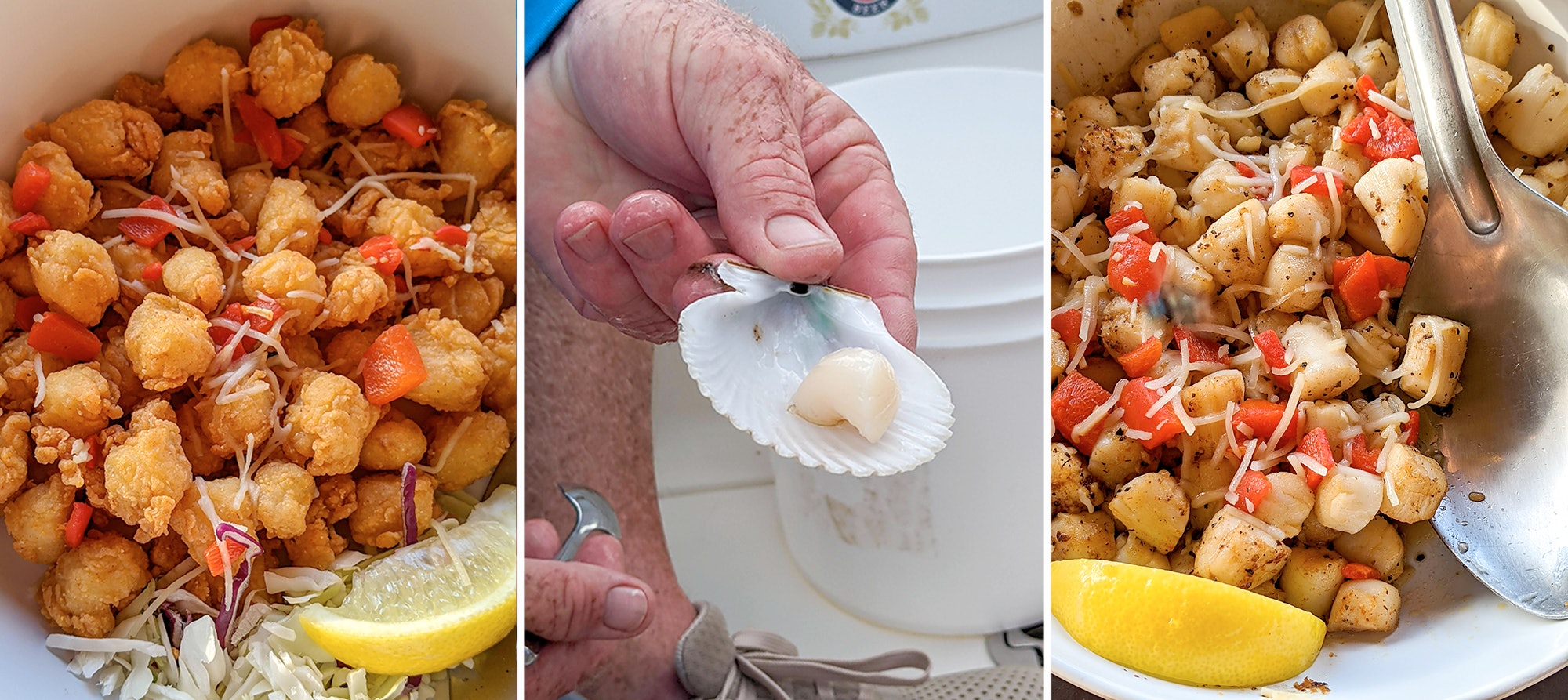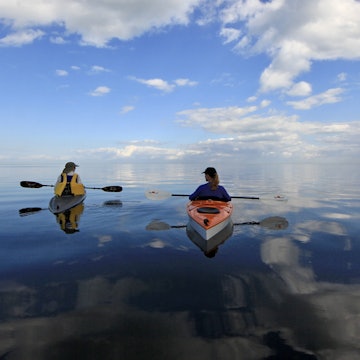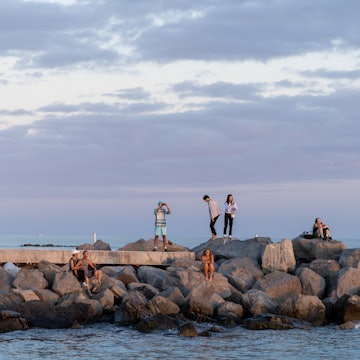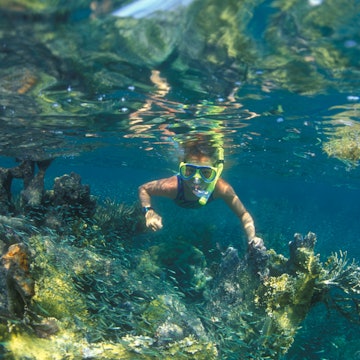
Snorkeling for scallops on Florida's Gulf Coast is a find-and-feast underwater adventure

Aug 25, 2022 • 9 min read

Snorkeling for scallops just off the coast of Florida in the Gulf of Mexico © Steven Martine / Lonely Planet
We boarded our scalloping boats at 9am. The temperature already had crossed into the 80s and the summer humidity floated at a muggy 85 percent. Less than an hour later, I was engulfed in a hide-n-seek hunt with Florida’s small and stealthy bay scallops. Ever since commercial scalloping was banned in Florida in the 90s, the only way to get a taste of this sweet meat is to strap on a snorkel and harvest them yourself.
In the water, heat and time no longer existed. One of my favorite things about the Gulf Coast is how warm the water is; there’s no shock as you dive through the surface of the water. Instead, it was a warm hug, engulfing me, welcoming me back home. I allowed a few loud and hollow breaths to pass through my snorkel before I dove underwater. The only sounds were the faint but familiar rhythm of my limbs pushing through the hazy, salty water.

The sensory deprivation left me free to focus on getting my eyes on the prize. And then picking up the prize and putting it in my netted catch bag, and then repeating that process until I had a bag full of scallops almost as big as the congratulations I’d surely receive from everyone on my team.
I'd been invited out here to take part in the annual scallop harvest, which draws thousands of people every year to dive in and hunt for the little elusive mollusks. Back at the marina before heading out, our group had been split up onto two boats, effectively separating us into two teams. Whichever boat brought in the most scallops would be crowned winner, but we’d all share in the sweet rewards of our combined haul at lunch. On my boat, we upped the ante by tacking on a little extra-friendly competition between teammates, too.
If recreational scalloping wasn’t already a competitive sport, it was now.
The most romantic trips in Florida for sun, sand and swoons
What makes Florida bay scallops so special?
Florida’s scalloping history dates back over 1000 years, possibly longer. Shell middens – ancient heaps of discarded shells – containing evidence of scallops, oysters, quahogs and whelk have been found all over the state.

Once upon a time, Florida’s bay scallops could be found as far east as the waters off Pensacola in the Panhandle, as far south as the Florida Keys, and as far west as the Atlantic Coast’s West Palm Beach. Between the 1920s and 1940s, the scallop population was plentiful enough to support Florida’s booming commercial and recreational scalloping demands. Commercial scalloping peaked in the mid-40s, but the high demand took its toll. By the 1960s, scallop populations and the commercial industry were struggling.
Unfortunately, more decades of unregulated overfishing and habitat loss followed, and restrictions on scalloping weren’t put into place until 1985, when, for the first time ever, the state introduced closed season dates and harvest limits. It was almost too little and too late.

By 1994, scallop populations were near-decimated and drastic measures were taken. Commercial scalloping was completely banned statewide — meaning Florida bay scallops could no longer be harvested for sale, taking them out of fish markets and off all restaurant menus. Additionally, recreational harvesting was prohibited south of the Swanee River (and later, in 2002, in all waters west of the Mexico Beach Canal in Bay County).
In Pasco County, which sits south of the Swanee, it took over 25 years to lift the recreational scalloping ban. After two trial seasons, the ban was officially lifted in 2020, though the county has only been granted a 10-day harvest season — by far the shortest in the state — to ensure the local scallop population can be sustained.
Sun, sea and swamp: introducing Florida’s national parks
Tips for spotting scallops
Scallop population numbers were on my mind with every lung-busting sweep I took in the warm waters off Pasco County’s New Port Richey. Scalloping wasn’t the easy Easter egg hunt I’d imagined. Turns out, scallops are pros at camouflage, and, more often than not, when my eyes crawled the sand and seagrass, I came back to the surface empty handed. It was only day two of Pasco’s 10-day season, so the beds couldn’t be too picked over — was I just bad at this?

“You’ve gotta look for their eyes,” our captain, Mark Dillingham, told us. He slid the tip of his thick, freckled forefinger down his equally-freckled thumb, until there was only enough space left for a speck of light to get through, demonstrating the minuscule size of the scallop’s eyes.“They’ve got rows of really tiny, really bright blue eyes that make ‘em easier to spot, but you gotta grab ‘em quick because if it sees you coming it’ll shoot away.” He laughed, but he wasn’t joking.
Florida bay scallops are unique bivalves with a flair for dramatic exits. When these mollusks feel threatened or startled, they activate their pump-and-propel mode. This involves the scallop rapidly closing their shells and using their valves as jet pumps to shoot them backward, sideways, anyways — as long as it’s away. And you better believe that with 20 to 30 pairs of eyes, they will almost always see you coming.

For me, the best approach ended up being to look for the unmistakable eyes and then slowly approach the scallop without reaching for it. Usually, their first line of defense would be to clamp up — and that’s when I’d grab them and toss them into my regulation netted catch bag.
On this trip, one particularly deft scallop used its quick pump-and-propel escape method to Houdini its way out of my catch bag just as I was placing it inside. It happened so fast that I was just left to watch the brainless bivalve frantically zig-zag backwards into the salty water until it disappeared.
The 8 best campgrounds in Florida
Where and when can you go snorkeling for scallops in Florida?
Pasco County’s small but growing scallop population may have made my harvest particularly challenging, but I’m always up for a challenge. In this case, it made me appreciate the scallops and their Floridian history even more — and indulging in the fresh-caught fruits of our labor taste even sweeter. But depending where and when you’re on the Gulf Coast, you can set the challenge level for your own find-and-feast (or search-and-snack) bay forage.

Florida bay scallops live in seagrass beds at shallow depths between four and 10ft so you don’t have to go too far offshore to get started on your scavenger hunt. Some scallop snorkel trips don’t even require swimming; you just wade into the water wearing a mask, plucking up shells as you spot them in the wiggling seagrass beds.
Currently, scalloping is allowed in designated areas along the Gulf Coast, from around Mexico Beach in the central Panhandle down through the southernmost border of Pasco County.
The healthiest populations are concentrated along the state’s Big Bend Shellfish Trail, starting in Franklin County around St. Vincent Island and following the curve of the coastline down to southern Hernando County, cutting off at Aripeka. These areas have the earliest season starts (June 15 and July 1) and can boast the longest harvest seasons (over 80 days). The most popular spots in these zones are Steinhatchee, Crystal River and Homasassa.
The Gulf County Zone includes all waters west of the Mexico Beach Canal up to the westernmost side of St. Vincent Island. Scalloping is only allowed here for about five weeks, starting in mid-August — still lengthy compared to the 10-day season in Pasco County, which kicks off on the third Friday in July.
5 best Florida road trips for 2022

How do they keep scalloping sustainable?
After three hours in the water, we’d reached our daily bag limit; four pints of shucked scallop meat per boat (or 10 gallons of scallops still in the shell). Bag limits, either per person or per boat, are one of the regulations that Florida uses to help prevent overfishing and keep recreational scalloping sustainable, and vary by zone.
Other regulations include only permitting harvesting done by hand or using a landing or dip net and implementing limited seasons based on the local scallop population. You also need a Florida saltwater fishing license or have a no-cost shoreline fishing license that allows scallopers to harvest in shallow waters on foot without the help of a boat. For tourists, licensed fishing boat charters are your ticket in.
According to Emily Abellera, a spokesperson for the Florida Fish and Wildlife Conservation Commission (FWC), top priorities also include scallop restoration.
“To increase depleted scallop populations in some bays and reintroduce scallops in other suitable areas from which scallops have disappeared, FWC began a 10-year Bay Scallop Restoration Plan in 2016,” she explained over email.

From manatees to mermaids: the 9 best state parks in Florida
The current project takes place in the Panhandle and runs in three parts: creating a hatchery in protected waters using a sample of the current scallop population; rearing scallop larvae into monitored settlements; and then releasing juvenile hatchery scallops into “wild” areas with low natural scallop populations.
The agency also conducts seasonal harvesting surveys, performs ongoing population monitoring and has created self-reported harvesting surveys that the public can fill out to share information on where they went scalloping, what their haul numbers were, and how long it took them to find their catch.
“Every year, FWC scallop biologists conduct surveys to estimate scallop population density along Florida’s Gulf Coast after the season ends to help us understand how many scallops are available to spawn and produce new scallops for the next year,” Abellera added.

After we packed it in and counted our catch, we headed straight for the docks at a local restaurant that offers catch-and-cook — you bring your fresh catch and they’ll cook it and serve it to you at your table. Captain Mark kept us busy during the hour-long ride by having us shuck and clean our scallops using spoons to open the shells, remove the guts, and scoop out the meat as our stomachs grumbled.
If you are the type of traveler who looks for immersive experiences or loves to try local delicacies, snorkeling for Florida bay scallops needs to be on your list. And, if you’re the type of person who likes to know where your food comes from — well, this is one fun way to find out firsthand.
(Oh, and in case anyone was wondering: I won, by one shell.)
12 best things to do in Florida
Katherine Alex Beaven traveled to New Port Richey, Florida, by invitation from Florida’s Sports Coast.















